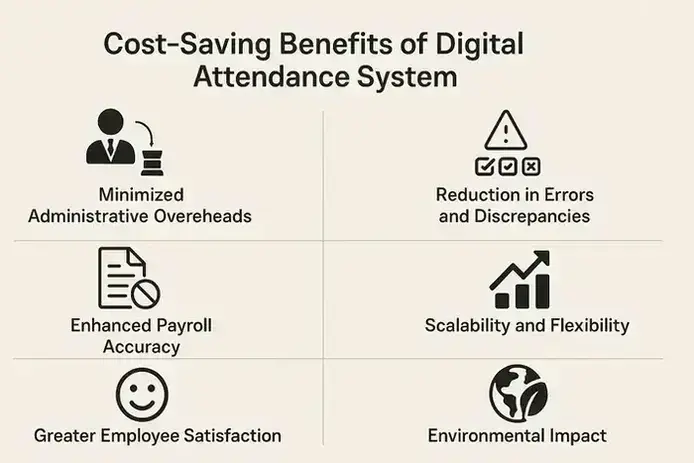Cost-Saving Benefits of Transitioning to a Digital Attendance System
Published: April 01, 12:15 PM

Managing employee attendance is a crucial part of business operations, but traditional methods like paper logs, punch cards, or manual tracking are costly, prone to errors, and inefficient. As companies look to cut unnecessary expenses, adopting a digital attendance system offers a smart and cost-effective solution. Here's a closer look at how this transition can save your business money in the long run.
1. Minimized Administrative Overheads
The manual process of recording attendance often involves hours of administrative work. Employees may need to manually sign in, HR staff spends time verifying and correcting data, and managers face delays in accessing up-to-date attendance records. With a digital attendance system, all of these tasks are automated. This leads to significant time savings for your team, allowing them to focus on more productive activities and reducing the need for excessive administrative support.
2. Elimination of Paper-Based Processes
A significant amount of time and money is spent on paper forms, attendance sheets, and storing these records. From printing to organizing and archiving, these processes not only add costs but also take up valuable physical space. A digital attendance system cuts out the need for paper completely, reducing printing costs and space consumption while ensuring that all records are stored securely and are easily accessible when needed.
3. Reduction in Errors and Discrepancies
Human error is a common issue in manual attendance tracking, whether it’s in the form of incorrect data entry, missed punches, or mistakes in calculations. These errors can lead to incorrect payroll processing, resulting in overpayments or underpayments, and even disputes with employees. A digital system ensures accuracy by automating the entire process, reducing mistakes and the costly time spent correcting them.
4. Enhanced Payroll Accuracy
Payroll processing can be a complex task, especially if attendance data is recorded manually. Miscalculations or delays in updating attendance records can result in payroll errors, causing dissatisfaction among employees or requiring time-consuming corrections. Digital attendance systems integrate directly with payroll software, ensuring that your team is paid accurately and on time every cycle, reducing administrative overhead and the risk of fines or penalties due to errors.
5. Improved Time and Resource Management
Tracking attendance digitally gives managers real-time insights into employee working hours, absences, and trends. This visibility allows businesses to make informed decisions about resource allocation, productivity, and workforce planning. By identifying patterns such as high absenteeism or overtime issues, you can take proactive steps to optimize staffing levels and manage resources more effectively.
6. Scalability and Flexibility
As your business grows, the need for a more scalable solution becomes apparent. Manual systems struggle to keep up with a larger workforce, leading to inefficiencies and additional costs. A digital attendance system is highly scalable, making it easy to add more employees and handle larger volumes of data without the need to hire additional staff or invest in further infrastructure. This adaptability ensures long-term cost savings as your business expands.
7. Reduced Risk of Time Theft
In traditional attendance systems, "buddy punching" (where one employee punches in for another) and time theft are common problems. These issues can lead to significant losses for an organization. Digital attendance systems often include features like biometric scans, facial recognition, or RFID cards, which help ensure that employees are only clocking in and out when they are physically present. This reduces the risk of fraud and time theft, protecting your business from unnecessary losses.
8. Greater Employee Satisfaction
Employees benefit from digital attendance systems as well. They no longer need to deal with manual timesheets, missing punches, or payroll discrepancies. In some cases, employees can even check their own attendance records in real-time, leading to greater transparency and fewer misunderstandings. Happier employees are often more productive and loyal, which can save your business money in the form of reduced turnover and fewer HR-related issues.
9. Environmental Impact
By going paperless, businesses can contribute to reducing their environmental footprint. The savings on paper, ink, storage space, and other physical resources are beneficial for both your bottom line and the planet. Plus, many digital attendance systems can be accessed remotely, which is particularly beneficial for businesses with multiple locations or remote employees.
Conclusion
Transitioning to a digital attendance system offers numerous cost-saving benefits that can have a lasting impact on your business. From reducing administrative burdens to eliminating human errors and improving payroll accuracy, digital attendance systems make managing attendance more efficient and cost-effective. As businesses look for ways to improve their bottom line, embracing this technology is a smart, sustainable investment.
Top Blogs
Published: March 18, 2025

Enhancing Workplace Security with an Advanced Visitor Management System
Published: March 04, 2025

The Environmental Impact of Digital Attendance Systems
Published: Feb 04, 2025

The Future of Remote Work: AI Attendance Solutions for Distributed Teams
Published: Jan 23, 2025

How Smart Devices Are Changing the Landscape of Attendance Tracking
Published: Jan 08, 2025

Why Real-Time Attendance Monitoring is Crucial for Operational Efficiency
Published: Dec 20, 2024

How to Manage Attendance Across Multiple Locations with Ease
View All
